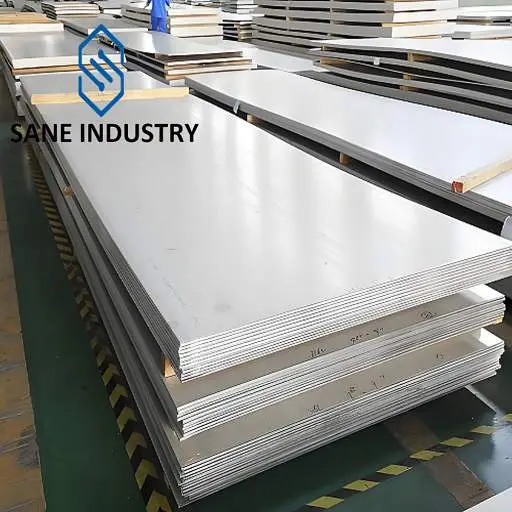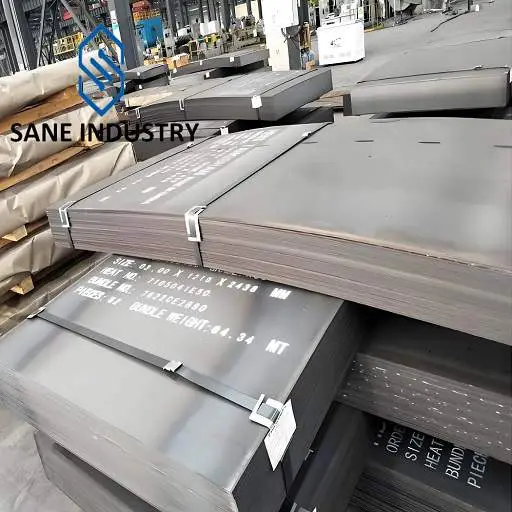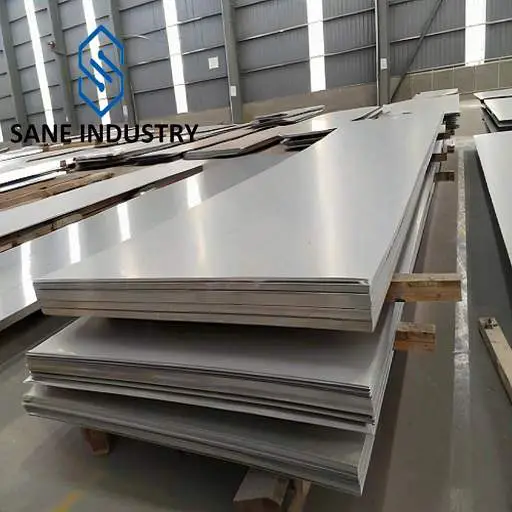What is a Stainless Steel Plate
A stainless steel plate(also known as stainless steel sheet) is a flat-rolled product manufactured from an alloy primarily composed of iron, chromium (minimum 10.5–11%), and often other elements like nickel, molybdenum, or carbon. Characterized by exceptional corrosion resistance and durability, it serves as a foundational material across industries due to its adaptability in thickness (typically ranging from 0.3mm to 200mm) and surface finishes.
Types of Stainless Steel Plates
Austenitic (300-series)
- Grades: 304 stainless steel plate(general-purpose), 316 stainless steel plate(Mo-added for marine/chemical resistance), 321 stainless steel plate(Ti-stabilized for high temps).
- Features: Non-magnetic, excellent corrosion resistance, ductile.
- Applications: Food processing, architecture, medical equipment.
Ferritic (400-series)
- Grades: 430 stainless steel plate(chromium-based), 439 stainless steel plate(Ti-stabilized for automotive).
- Features: Magnetic, moderate corrosion resistance, cost-effective.
- Applications: Appliances, automotive exhausts, decorative trim.
Martensitic
- Grades: 410 stainless steel plate, 420 stainless steel plate(high carbon for hardness).
- Features: Magnetic, heat-treatable, wear-resistant.
- Applications: Cutting tools, turbine blades, valves.
Duplex
- Grades: 2205 stainless steel plate(22% Cr, 5% Ni), 2507 stainless steel plate(super duplex).
- Features: Mixed austenitic-ferritic structure, high strength, chloride resistance.
- Applications: Offshore platforms, chemical tanks, desalination plants.
Precipitation-Hardening (PH)
- Grades: 17-4PH, 15-5PH.
- Features: Strengthened via heat treatment, corrosion-resistant.
- Applications: Aerospace components, nuclear reactors, high-stress machinery.
What are the advantages of Stainless Steel Plates
Corrosion Resistance
A chromium-rich oxide layer forms naturally, preventing rust and degradation in harsh environments (e.g., saltwater, acids).Durability & Strength
High mechanical strength and wear resistance ensure longevity under heavy loads or abrasive conditions.Hygienic Properties
Non-porous surface inhibits bacterial growth, ideal for food processing, medical tools, and cleanrooms.Aesthetic Versatility
Available in polished, brushed, or patterned finishes for architectural, decorative, or industrial design.Heat & Chemical Resistance
Retains structural stability at high temperatures and resists chemical reactions, suitable for boilers and chemical tanks.
What are the disadvantages of Stainless Steel Plates
Higher Cost
More expensive than carbon steel or aluminum due to alloying elements (e.g., chromium, nickel).Heavy Weight
High density complicates transport and installation, increasing project costs.Fabrication Challenges
Requires specialized tools for cutting/welding; prone to warping if improperly handled.Thermal Conductivity
Poor heat dissipation compared to copper or aluminum, limiting use in high-efficiency heat exchangers.Surface Sensitivity
Polished finishes scratch easily or show fingerprints, demanding careful maintenance.Galvanic Corrosion Risk
Can corrode when paired with dissimilar metals (e.g., carbon steel) in wet environments.
How are Stainless Steel Plates made
- Raw Material Preparation
Stainless steel plates start with a mixture of iron ore, chromium (minimum 10.5%), and other alloying elements like nickel, molybdenum, or titanium. These components are melted in an electric arc furnace (EAF) or argon oxygen decarburization (AOD) converter to achieve precise chemical composition. - Casting & Forming
The molten steel is cast into slabs or billets. These slabs are then heated and rolled through hot-rolling mills to reduce thickness and form large metal sheets. Hot-rolled plates have a rough surface and require further processing. - Cold Rolling & Annealing
For thinner, smoother plates, hot-rolled sheets undergo cold rolling. This process enhances strength and surface finish. Annealing (controlled heating and cooling) follows to relieve internal stresses and restore corrosion resistance. - Surface Treatment
Plates are pickled in acid solutions to remove impurities and oxide layers. Optional treatments include polishing (mirror or brushed finishes), embossing (textured patterns), or coating for specialized applications. - Cutting & Quality Control
Plates are cut to size using laser, plasma, or waterjet methods. Final inspections check thickness uniformity, mechanical properties, and corrosion resistance through tests like ultrasonic scanning or salt-spray analysis.
What is a stainless steel plate used for
Construction & Architecture
Used for cladding, roofing, and structural supports due to durability and aesthetic appeal (e.g., skyscrapers, bridges, decorative façades).Food & Beverage Industry
Ideal for tanks, countertops, and conveyor systems because of hygiene, corrosion resistance, and ease of cleaning.Medical & Pharmaceutical Equipment
Manufacture surgical tools, sterilization devices, and MRI machines, leveraging their non-reactive and sterilizable surfaces.Chemical & Energy Sectors
Build reactors, piping, and storage tanks for corrosive chemicals, oil refineries, and nuclear power plants.Transportation
Fabricate components like ship hulls, aircraft parts, and automotive exhaust systems to resist rust and extreme temperatures.Consumer Goods
Used in kitchen appliances (sinks, cookware), elevators, and signage for sleek design and longevity.
Our Stainless Steel Plates Sizes and Material Grade
| Name | Stainless Steel Plates | |
| Thickness | 0.2 to 350 mm | 0.008” to 13.8” |
| Width | ≤4,100 mm | ≤14 ft |
| Length | ≤25,000 mm | ≤82 ft |
| Material | SA240(S41008, S20100, S30400, S30403, S32100, S34700, S31600, S31603, S31700, S31703, N08800, N08810), any other | |
For other customized requirements, please contact us.
What is the Stainless Steel Plate Price
Please contact our sales manager Allen@sanesteel.com
Why Choose Us
- a 16-year stainless steel plate supplier. We are experts.
- solutions for all your needs
- the highest product quality
- the low lead times
- excellent customer service





